Potrebujeme váš súhlas na využitie jednotlivých dát, aby sa vám okrem iného mohli ukazovať informácie týkajúce sa vašich záujmov. Súhlas udelíte kliknutím na tlačidlo „OK“.
ASTM E2555-07(2012)
Standard Practice for Factors and Procedures for Applying the MIL-STD-105 Plans in Life and Reliability Inspection
Automaticky preložený názov:
Štandardné praktiky pre faktorov a postupov pre uplatňovanie MIL-STD-105 plánov v životnosti a spoľahlivosti inšpekcie
NORMA vydaná dňa 1.5.2012
Informácie o norme:
Označenie normy: ASTM E2555-07(2012)
Poznámka: NEPLATNÁ
Dátum vydania normy: 1.5.2012
Kód tovaru: NS-45591
Počet strán: 24
Približná hmotnosť: 72 g (0.16 libier)
Krajina: Americká technická norma
Kategória: Technické normy ASTM
Kategórie - podobné normy:
Anotácia textu normy ASTM E2555-07(2012) :
Keywords:
exponential distribution, hazard rate, mean life, MIL-STD-105, reliability, reliable life, Weibull distribution, Exponential distribution, Hazard assessment/potential, Reliability, Weibull parameters, MIL-STD-105, ICS Number Code 07.020 (Mathematics)
Doplňujúce informácie
| Significance and Use | ||||||
|
The procedure and tables presented in this practice are based on the use of the Weibull distribution in acceptance sampling inspection. Details of this work, together with tables of sampling plans of other forms, have been published previously. See Refs (1-3). Since the basic computations required have already been made, it has been quite easy to provide these new factors. No changes in method or details of application have been made over those described in the publications referenced above. For this reason, the text portion of this report has been briefly written. Readers interested in further details are referred to these previous publications. Other sources of material on the underlying theory and approach are also available (4-7). The procedure to be used is essentially the same as the one normally used for attribute sampling inspection. The only difference is that sample items are tested for life or survival instead of for some other property. For single sampling, the following are the required steps: Using the tables of factors provided in Annex A1, select a suitable sampling inspection plan from those tabulated in Practice E2234. Draw at random a sample of items of the size specified by the selected Practice E2234 plan. Place the sample of items on life test for the specified period of time, t. Determine the number of sample items that failed during the test period. Compare the number of items that failed with the number allowed under the selected Practice E2234 plan. If the number that failed is equal to or less than the acceptable number, accept the lot; if the number failing exceeds the acceptable number, reject the lot. Both the sample sizes and the acceptance numbers used are those specified by Practice E2234 plans. It will be assumed in the section on examples that single sampling plans will be used. However, the matching double sampling and multiple sampling plans provided in MIL-STD-105 can be used if desired. The corresponding sample sizes and acceptance and rejection numbers are used in the usual way. The specified test truncation time, t, must be used for all samples. The probability of acceptance for a lot under this procedure depends only on the probability of a sample item failing before the end of the test truncation time, t. For this reason, the actual life at failure need not be determined; only the number of items failing is of interest. Life requirements and test time specifications need not necessarily be measured in chronological terms such as minutes or hours. For example, the life measure may be cycles of operation, revolutions, or miles of travel. The underlying life distribution assumed in this standard is the Weibull distribution (note that the exponential distribution is a special case of the Weibull). The Weibull model has three parameters. One parameter is a scale or characteristic life parameter. For these plans and procedures, the value for this parameter need not be known; the techniques used are independent of its magnitude. A second parameter is a location or “guaranteed life” parameter. In these plans and procedures, it is assumed that this parameter has a value of zero and that there is some risk of item failure right from the start of life. If this is not the case for some applications, a simple modification in procedure is available. The third parameter, and the one of importance, is the shape parameter, β. The magnitude of the conversion factors used in the procedures described in this report depends directly on the value for this parameter. For this reason, the magnitude of the parameter shall be known through experience with the product or shall be estimated from past research, engineering, or inspection data. Estimation procedures are available and are outlined in Ref (1). For the common case of random chance failures with the failure rate constant over time, rather than failures as a result of “infant mortality” or wearout, a value of 1 for the shape parameter shall be assumed. With this parameter value, the Weibull distribution reduces to the exponential. Tables of conversion factors are provided in Annex A1 for 15 selected shape parameter values ranging from ½ to 10, the range commonly encountered in industrial and technical practice. The value 1, used for the exponential case, is included. Factors for other required shape parameter values within this range may be obtained approximately by interpolation. A more complete discussion of the relationship between failure patterns and the Weibull parameters can be found in Refs (1-3). One possible acceptance criterion is the mean life for items making up the lot (μ). Mean life conversion factors or values for the dimensionless ratio 100t/μ have been determined to correspond to or replace all the p' or percent defective values associated with Practice E2234 plans. In this factor, t represents the specified test truncation time and μ the mean item life for the lot. For reliability or life-length applications, these factors are used in place of the corresponding p' values normally used in the use of Practice E2234 plans for attribute inspection of other item qualities. The use of these factors will be demonstrated by several examples (see Sections 5, 7, and 9). Annex Table 1A lists, for each selected shape parameter value, 100t/μ ratios for each of the Practice E2234 AQL [p'(%)] values. With acceptance inspection plans selected in terms of these ratios, the probability of acceptance will be high for lots whose mean life meets the specified requirement. The actual probability of acceptance will vary from plan to plan and may be read from the associated operating characteristic curves supplied in MIL-STD-105. The curves are entered by using the corresponding p'(%) value. Annex Table 1B lists 100t/μ ratios at the LQL for the quality level at which the consumer's risk is 0.10. Annex Table 1C lists corresponding 100t/μ ratios for a consumer's risk of 0.05. These ratios are to be used directly for the usual case for which the value for the Weibull location or threshold parameter (γ) can be assumed as zero. If γ is not zero but has some other known value, all that shall be done is to subtract the value for γ from t to get t0 and from m to get m0. These transformed values, t0 and m0, are then employed in the use of the tables and for all other computations. A solution in terms of m0 and t0 can then be converted back to actual or absolute values by adding the value for γ to each. |
||||||
| 1. Scope | ||||||
|
1.1 This practice presents a procedure and related tables of factors for adapting Practice E2234 (equivalent to MIL-STD-105) sampling plans to acceptance sampling inspection when the item quality of interest is life length or reliability. Factors are provided for three alternative criteria for lot evaluation: mean life, hazard rate, and reliable life. Inspection of the sample is by attributes with testing truncated at the end of some prearranged period of time. The Weibull distribution, together with the exponential distribution as a special case, is used as the underlying statistical model. 1.2 A system of units is not specified by this practice. 1.3 This standard does not purport to address all of the safety concerns, if any, associated with its use. It is the responsibility of the user of this standard to establish appropriate safety and health practices and determine the applicability of regulatory limitations prior to use. |
||||||
| 2. Referenced Documents | ||||||
|
Podobné normy:
Historická
1.8.2012
Historická
1.7.2010
Historická
1.4.2013
Historická
1.4.2014
Historická
15.11.2013
Historická
1.3.2013


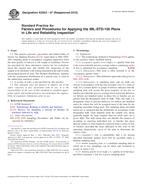
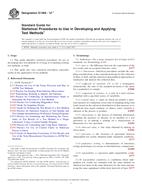 ASTM E1488-12e1
ASTM E1488-12e1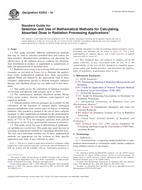 ASTM E2232-10
ASTM E2232-10 ASTM E2234-09(2013)..
ASTM E2234-09(2013)..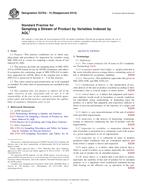 ASTM E2762-10(2014)..
ASTM E2762-10(2014)..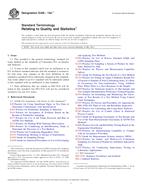 ASTM E456-13ae1
ASTM E456-13ae1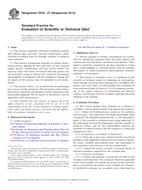 ASTM E678-07(2013)..
ASTM E678-07(2013)..
 Cookies
Cookies
